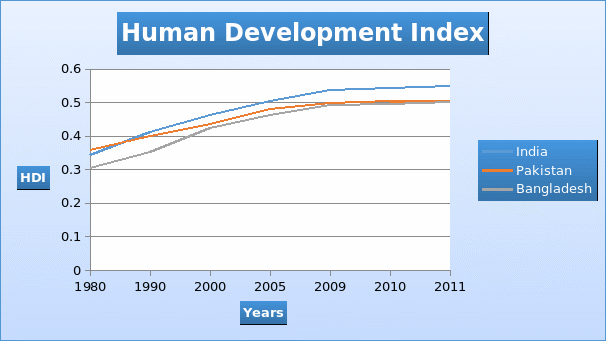Human development index (HDI) is used by organizations to estimate and rank economic status of countries based on certain criteria. The key components of life expectancy are income, education and life expectancy (Nagel 2). In this paper, the HDI for three countries, these are, India, Pakistan, and Bangladesh will be compared.
Based on the first criterion, that is, life expectancy at birth, Bangladesh had the highest value at 68.9 years while India and Pakistan had a tie at 65.4 years. The values indicate that Bangladesh has a better health care system than the other two countries.
Based on the second criterion, Pakistan had the highest mean years of schooling at 4.9 years, followed by Bangladesh at 4.8 years and India at 4.4 years. The values show that the citizens of Pakistan spend more years in school than the other two countries. The third criterion is the expected years of schooling.
Based on this measure, India reported the highest value at 10.3 years, followed by Bangladesh at 8.1 years and Pakistan with 6.9 years. Thus, when analyzing the first three components of the HDI, it can be observed that there is a small margin between the three countries.
The final component is the GNI (gross national income) per capita. India had the highest GNI per capita estimated at $3,468, followed by Pakistan at $2,550 while Bangladesh had $1,529. The ratio shows that the citizens of India have a higher standard of living than the other countries.
When all the four components are put together, India had the highest HDI at 0.547, followed by Pakistan at 0.504 while Bangladesh had 0.500 (The United Nations Development Programme 23). Thus, based on HDI India has a better well-being than the other countries.
Trend of HDI between 1980 and 2011
The graph presented below shows the trend of HDI of the three countries between 1980 and 2011.

In the graph, it can be observed that Pakistan had the highest HDI in 1980. Over time, the HDI of India grew and surpassed that of Pakistan.
Bangladesh had the least HDI in 1980. Over the years, the HDI of Bangladesh increased and it is closing in on the HDI for Pakistan. Thus, it can be noted that India and Bangladesh have reported a tremendous increase in HDI since 1980.
Other social indicators
There are a number of other social indicators that can be used to compare the well-being of these countries. The first indicator is the percentage of population living with less than $1.25 a day. Pakistan had the least percentage of population at 22.6%, followed by India at 41.6% and Bangladesh at 49.6%.
Thus, the poverty level is low in Pakistan and high in Bangladesh. Secondly, the adult literacy rate is high in India at 62.8%, followed by Bangladesh at 55.9% and Pakistan at 55.5%. Thus, the level of education is high in India and low in Pakistan.
Thirdly, the under-five mortality rate is low in Bangladesh at 52 per 1000 live births, followed by India at 66 while Pakistan had 87. The values indicate that Bangladesh provides better health care for infants than the other countries.
Finally, the public expenditure on education and total expenditure on health measured as a percentage of GDP were high in India followed by Bangladesh and Pakistan.
In summary, the above indicators show that India would rank first based on the overall well-being followed by Pakistan and Bangladesh. This ranking is based on the knowledge that India has the highest HDI while Bangladesh has the least HDI.
Works Cited
Nagel, Robert. Human Development Index – An Elaborate Means of Evaluating a Country’s HD, Munich, Germany: GRIN Verlag, 2007. Print.
The United Nations Development Programme 2011, Human Development Report 2011. PDF file. 21 Jan. 2014. <https://www.undp.org/content/dam/undp/library/corporate/HDR/2011%20Global%20HDR/English/HDR_2011_EN_Complete.pdf>.